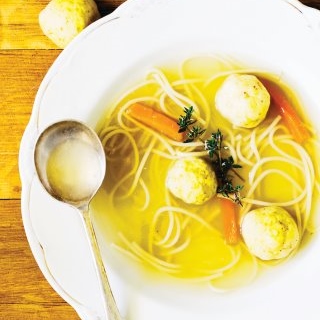click to dowload our latest edition
CLICK HERE TO SUBSCRIBE TO OUR NEWSLETTER


Published
5 years agoon
By
adminJORDAN MOSHE
Beyond its legendary status as a comfort food, this iconic and quintessentially Jewish dish has also been feted as something of a cure-all, ladled out generously at the first sign of cold, heartbreak, or any other physical or emotional malaise.
But how did the famed dish become a Jewish icon, and just how healthy is a bowl of chicken soup? Is this golden broth truly the “Jewish penicillin”, or is this status nothing but a bobba mayseh (old wives’ tale)?
Chicken soup is considered a restorative dish in many cultures, among them Chinese communities where traditional medicine is practised. Archaeological evidence suggests that people started using poultry in soup soon after they discovered how to boil water.
The earliest recorded evidence of chicken soup being used as a therapeutic dish dates back to Chinese antiquity. Medical practitioners hailed the elixir a “yang food” – a warming dish capable of curing various diseases. Like the Chinese, Greek physician Galen recommended chicken soup for curing ailments such as migraine, leprosy, constipation, and fever.
Belief in the curative properties of chicken soup travelled across the globe, and Jews were also convinced of its medicinal powers. The Talmud related that the chicken of the sage Rabbi Abba, when cooked, served him as a general remedy.
Towards the end of the Middle Ages, the Jewish philosopher and physician, Maimonides, recommended chicken soup for the weak and the sick. In his book, On the Cause of Symptoms, he recommends broth cooked with hens and other fowl to “neutralise body constitution”. Such a dish, he says, also plays a role in curing leprosy and asthma.
Still, the dish remained relatively uncommon until the 15th century, when a revival in the practice of raising chickens compensated for the scarcity of other foods, and people began to eat chicken soup regularly. The first Ashkenazic chicken soup was made in the poor Jewish villages of Russia, a product of the thrifty use of every part of the chicken to make a different dish.
Bones and remaining scraps went into the pot with water and seasoning, creating a dish to be eaten alongside pupiks, schmaltz, p’tcha, and chopped liver. Sephardi Jews developed their own variations, customarily dishing out a caldo de gayina vieja, or old hen chicken broth, to women who had given birth, and sick people.
Recipes for chicken soup continued to be passed down for generations, and the properties of the dish extolled across the globe. The golden elixir reached the New World in the 16th century, but it was only in the 1800s that recipes first started being published and it was called “chicken soup”.
The American film producer and co-founder of Metro-Goldwyn-Mayer studios, Louis B. Mayer, insisted that chicken-matzo ball soup be served daily in his boardroom, made only using his mother, Sarah’s, recipe.
According to Joan Nathan’s book Jewish Cooking in America, the original recipe for the iconic Pesach dish was Sarah’s own creation. The dish continued to attract a following, and after World War II, Jewish emigrants continued popularising it in America, leading to its famous nickname, “Jewish penicillin”.
This title led many to question the true efficacy of chicken soup as a medicinal treatment. Scientists of the late 20th century were confused about what exact ingredient in the famed dish passed down from grandma activated the “healing”, and set out to determine the true extent of its power.
Countless studies were conducted in the 1980s and 1990s, with more than 1 000 scientists from respected institutions in the United States and European institutions trying to unravel the mystery. While the results varied, chicken soup’s curative properties were actually shown – to a certain extent.
“Although chicken soup is not going to cure any illness, it can help to relieve the symptoms of the common cold and flu,” said dietician Toni Brien. “It has thus become synonymous with ‘curing’ sickness, and it is commonly used when people are ill.”
She explained that hot soup helps to lessen nasal congestion, especially if it contains pepper, garlic, curry, or other spices. These ingredients thin mucus and make it easier to breathe, and it may loosen mucus on the lungs, making it easier to cough up and clear the lungs. “Chicken also contains an amino acid called cysteine which could further aid decongestion of the lungs,” she said.
“When you are sick, and have a fever or diarrhoea and vomiting, it’s important to stay well hydrated. Soup will keep you hydrated, as well as give your body nutrients and electrolytes which may be lost due to a loss of appetite.
“We usually find it easier to drink than eat when we are sick, especially if we have a sore throat. The salt in the soup may also sooth a sore throat.”
Soups with lots of vegetables might be better than chicken soup in terms of nutrient intake, but chicken soup certainly retains some status as a helpful brew.
Said Brien, “I wouldn’t say it fights flu, but it definitely relieves symptoms and can help you feel better while you fight the flu. I can’t be sure about it making medicine work better, but if you are eating and experience fewer symptoms, I’m sure you will feel like the medicine is working better.”
